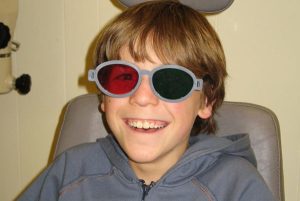What is Vision Therapy?
Optometric Vision Therapy is an individualized one-on-one program of therapeutic activities designed to improve visual efficiency and correct visual perceptual deficiencies. Vision Therapy sessions include procedures designed to enhance the brain’s ability to control eye alignment, eye teaming, eye focusing, eye movements, and visual processing. These important binocular vision skills provide a foundation to prevent eye strain, while improving our 3-D experience of the world.
Visual therapy procedures may involve the use of gross motor and balance activities to help develop our internal coordinate system needed to understand right and left directions. Visual perceptual activities are taught using kinesthetic, tactile and vestibular stimulation (mini trampoline). We incorporate rhythm in all our learning programs through the use of music and/or metronomes. The result is improved speed of processing!
Although children most commonly undergo vision therapy, it may help adults with visual challenges as well. Vision therapy can help with:
Poor Binocular Coordination & Focusing
Vision Therapy helps individuals develop accurate coordination and teamwork of the two eyes (binocular vision). When the two eyes fail to work together, performance in many areas can suffer (visual tracking while reading or following a ball playing sports). One may experience headaches, double vision or dizziness.
Learning-related Vision Problems
Reading fluency and reading comprehension are positively affected when basic visual skills such as eye tracking, focusing and convergence ability are improved with vision exercises. A child goes from “learning to read” to “reading to learn” when visual processing skills are enhanced (visual memory, visualization and visual speed).
Crossed Eyes (Strabismus) and Lazy Eye (Amblyopia)
Crossed eyes and lazy eyes can be treated with vision therapy, instead of conventional surgery, glasses and patching. Vision Therapy is effective at any age, improving eyesight and enhancing depth perception and 3-D vision needed for enhancing school performance
Computer Vision Syndrome
Our high-tech society requires many children and adults to do large amounts of work in front of a computer screen. Computer Vision Syndrome, is one of the fastest growing health concerns in the workplace today. Visual stresses on the visual system can induce eyestrain, headaches, and visual difficulties that can be effectively treated with corrective lenses or Vision Therapy.
Visual Rehabilitation for Special Populations (strokes, brain injury, developmental delays)
A neurological disorders or trauma to the nervous system can affect a person’s vision. This includes brain injuries, stroke, whiplash, developmental delays, multiple sclerosis and brain tumors. Vision Therapy can effectively treat the visual consequences of these conditions including double vision, lack of focus, visual field deficits and visual processing.
Sports Vision Improvement
Strong visual skills are critical to sports success. Athletes often use vision therapy to improve eye-hand coordination, reaction time and peripheral vision awareness, eye teaming and focusing, tracking, and visualization skills. Vision therapy is also recognized for helping one recover more quickly from concussion.




